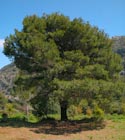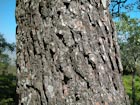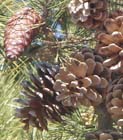Pinus halepensis
Miller 1768
Common names
Aleppo pine; الصنوبر الحلبي [Arabic]; Pin d'Alep [French]; pino d'Aleppo [Italian]; Alepski bor [Croation]; Halep çamı [Turkish]; אורן ירושלים [Hebrew]; pino carrasco [Spanish]. Aleppo is in Syria, where the species was first described. In California we call it freeway pine, because it is widely planted at freeway interchanges where it survives handily without any supplemental watering.
Taxonomic notes
Synonymy (Farjon 1998):
- P. alepensis Poir. in Lamarck 1804
- Pinus maritima Mill. 1768
- Pinus sylvestris L. var. maritima Aiton 1789
- Pinus maritima Aiton 1813 non Mill. 1768
- Pinus penicillus Lepeyr. 1813
- Pinus arabica Sieber ex Spreng. 1826
- Pinus genuensis S.E. Cook 1834
- Pinus halepensis Mill. var. genuensis (S.E. Cook) Antoine 1840
- Pinus hispanica J. Cook 1834
- Pinus halepensis Mill. var. minor Antoine 1840
- Pinus carica D. Don in Fellows 1841
- Pinus halepensis Mill. var. carica (D. Don) Carr. 1855
- Pinus abasica Carr. 1855
- Pinus halepensis Mill. var. abasica (Carr.) Carr. 1867
- Pinus loiseleuriana Carr. 1855
- Pinus pseudohalepensis Denhardt ex Carr. 1855
- Pinus parolinii Vis. 1856
- Pinus × saportae Rouy 1913
- Pinus ceciliae Llorens et L. Llorens 1984
- Pinus halepensis Mill. var. ceciliae (Llorens et L. Llorens) Rosello et al. 1992
Description
Trees 15–25 m tall and up to 150 cm DBH. Single round trunk, often divided to form in mature trees a rounded or flat-topped crown of slender, irregular horizontal, upturned branches; crown form often shaped by wind, especially near the sea. Bark at first smooth silvery gray, later becomings purple-brown, longitudinally grooved and fissured into scaly plates. Branchlets smooth, slightly ridged, gray-green. Winter buds conic, 8 mm long, the scales fringed and often reflexed. Needles in fascicles of 2(–3), 5–12 cm × 1 mm, twisted, edges minutely serrate, with stomata on all surfaces; rather sparsely arrayed along the branchlets. Fascicle sheath persistent but fragile. Seed cones on thick, scaly peduncles; at maturity ovoid, pendant, 6–12 × 4–7 cm, symmetrical, red- to purple-brown, solitary or in whorls of 2–3. Cones take 3 years to mature and remain on branches for long thereafter. Cone scales shiny, yellow- or red-brown, about 2.5 × 1.5 cm, apophysis rhomboid, flat or slightly raised and keeled, without a prickle. Seed 5-6 mm long with a 2.5 cm wing (Dallimore et al. 1967, Farjon 1984).
P. halepensis and P. brutia var. eldarica have very similar appearance in habitat. P. brutia var. eldarica has a significantly shorter cone peduncle (2.5 vs. 11 mm), longer needles (11 vs. 6.5 cm), and cones strongly pointing toward branch tip (vs. pointing somewhat towards branch pase in P. halepensis). In overall form, P. brutia var. eldarica has more erect growth with a more uniform and more dense crown, while P. halepensis commonly has a less erect and more open crown (Ritter n.d.). The species have disjunct ranges, but co-occur in some areas where planted or naturalized.
Distribution and Ecology
Mediterreanean and W Asia: Morocco, Algeria, Tunisia, Libya, Israel, Jordan, Syria, Lebanon, Turkey, Greece, Albania, Montenegro, Bosnia & Herzegovina, Croatia, Italy, Malta, France, and Spain. In South Africa, where it is cultivated for shelter poles and firewood, it has naturalized and invaded grassland and fynbos, particularly on dry soils, and become widespread in the Eastern Cape and the Western Cape (Palgrave 2002). It is also locally naturalized in USA: California (PLANTS database 2009.03.31). Hardy to Zone 8 (cold hardiness limit between -12.1°C and -6.7°C) (Bannister and Neuner 2001).
Remarkable Specimens
I have no data on wild trees. A specimen in Arderne Gardens, Claremont, Cape Town, South Africa was measured at 172 cm dbh and 32.0 m tall (Robert Van Pelt pers. comm., 2003.11.24).
The oldest known living specimen, 153 years, was documented in a tree-ring chronology covering the period 1854-2006 (crossdated after 1855), collected southwest of Djelfa, Algeria by Ramzi Touchan (doi.org/10.25921/x5fh-qx17). All samples on this site originated between 1854 and 1875, suggesting site initiation after disturbance (likely logging or fire) and thus implying that considerably older sites could exist. This site was used in a long-term drought study (Touchan et al. 2011).
Ethnobotany
In the eastern Mediterranean, Pinus halepensis forests are important for resin, fuelwood and forest honey production and also for livestock grazing. "Resin collection activities in Mediterranean countries had always played a significant role in the welfare of forest communities, some of which lived marginally at the edge of subsistence. In some low-income areas, resin collection was (and continue to be) the only reliable source of labor. In addition, many of the resin producing forests are community forests and production benefits go to resin community co-operatives. Another important aspect of these forests is that multiple purpose forestry is applied and other activities other than resin collection co-exist, such as apiculture... Income from the wood of a Pinus halepensis tree, for example, is only 2% of the income generated from resin throughout the lifetime of the tree (an average size tree can produce 3–4 kilograms of resin per year). Moreover, it has been observed that forests that have active resin production have lower incidence of forest fires. This results from the fact that adjacent communities have an active interest in preserving the integrity of the forest ecosystems" (Moussouris and Regato 1999).
Pioneering work in dendrochronology was carried out by Gindel (1944).
Observations
No data as of 2023.11.03.
Remarks
The epithet halepensis is Latin, "of Aleppo", referring to the city in Syria.
Citations
Gindel, J. 1944. Aleppo pine as a medium for tree-ring analysis. Tree-Ring Bulletin 11(1):6-8.
Miller, P. 1768. The Gardener's Dictionary, ed. 8. London. Pinus no. 8. Available: botanicus.org/title/b12066618, accessed 2011.05.20.
Ritter, Matt. [no date]. Pine trees (the genus Pinus). https://static1.squarespace.com/static/562016f1e4b0dc6edcb66948/t/5787faebd2b857a47c4f795f/1468529417903/Pinus+Lecture.pdf, accessed 2024.01.15.
Touchan, Ramzi, Kevin J. Anchukaitis, David M. Meko, Said Attalah, Christopher Baisan, and Ali Aloui. 2011. Spatiotemporal drought variability in northwestern Africa over the last nine centuries. Climate Dynamics 37(1):237-252. doi: 10.1007/s00382-010-0804-4
See also
Elwes and Henry 1906-1913 at the Biodiversity Heritage Library. This series of volumes, privately printed, provides some of the most engaging descriptions of conifers ever published. Although they only treat species cultivated in the U.K. and Ireland, and the taxonomy is a bit dated, still these accounts are thorough, treating such topics as species description, range, varieties, exceptionally old or tall specimens, remarkable trees, and cultivation. Despite being over a century old, they are generally accurate, and are illustrated with some remarkable photographs and lithographs.





